Back to Product Page
TUFLEX
EYE AND EYE ROUNDSLINGS
|
|
|
|
|
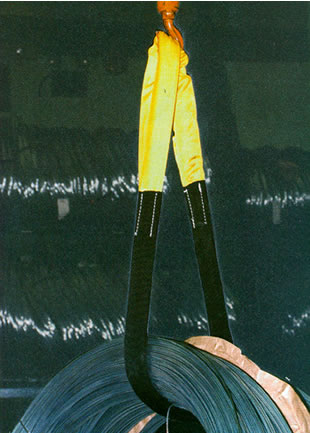 |
|
| A
More Rugged and Durable Tuflex |
|
|
|
|
|
|
|
| The
Eye and Eye Advantage |
|
|
|
|
|
|
|
An
additional jacket of texturized, abrasion resistant
nylon covers the body of the standard Tuflex,
forming two color coded lifting eyes. |
|
|
|
|
|
|
|
| Maintains
all the basic Tuflex features plus... |
|
|
|
|
|
|
|
 Saves money by extending sling life where
Saves money by extending sling life where
abrasion to sling body is a problem. |
|
|
|
|
|
|
|
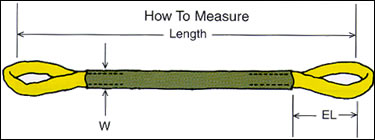 |
|
|
|
|
|
|
|
|
 |
|
Order
Online, by Phone, or by E-Mail |
|
|
|
~
Add items to your online shopping cart ~
Click a Price of the item you
wish to purchase.
|
|
|
|
|
*Constact
Us For Special Lengths*
|
|
|
|
Part
No. |
Color
of
Eyes |
Rated Capacity (lbs.)‡ |
Min.
Length
(ft.)+ |
Approximate Measurements |
Ext'd. prices @ lgths shown (ft.) |
|
Vertical |
Choker |
Basket |
Wgt.
(lbs./ft.) |
Body
Width
at Load
(W)
(in.) |
Std Eye
Length
(EL)
(in.) |
Min.
Hardware
Dia.
(in.)** |
3' |
4' |
6' |
8' |
Adder/
Ft. |
|
EE30 |
Purple |
|
2,600 |
2,100 |
5,200 |
4 |
0.25 |
2 1/4 |
10 |
1/2 |
*NA |
|
|
|
$6.44
|
|
EE60 |
Green |
|
5,300 |
4,200 |
10,600 |
4 |
0.36 |
2 1/2 |
10 |
5/8 |
*NA |
|
|
|
$7.96
|
|
EE90 |
Yellow |
|
8,400 |
6,700 |
16,800 |
4 |
0.5 |
2 1/2 |
12 |
3/4 |
*NA |
|
|
|
$9.74
|
|
EE120 |
Tan |
|
10,600 |
8,500 |
21,200 |
5 |
0.6 |
3 1/2 |
12 |
7/8 |
*NA |
*NA |
|
|
$11.16
|
|
EE150 |
Red |
|
13,200 |
10,600 |
26,400 |
5 |
0.84 |
3 1/2 |
14 |
1 |
*NA |
*NA |
|
|
$14.61
|
|
EE180 |
White |
|
16,800 |
13,400 |
33,600 |
7 |
0.96 |
3 1/2 |
16 |
1 1/8 |
*NA |
*NA |
*NA |
|
$17.80
|
|
EE240 |
Blue |
|
21,200 |
17,000 |
42,400 |
7 |
1.5 |
4 1/4 |
16 |
1 1/4 |
*NA |
*NA |
*NA |
|
$20.08
|
|
EE360 |
Grey |
|
31,000 |
24,800 |
62,000 |
7 |
1.8 |
6 |
20 |
1 1/2 |
*NA |
*NA |
*NA |
*NA |
*NA |
|
EE600 |
Brown |
|
53,000 |
42,400 |
106,000 |
8 |
2.7 |
7 |
24 |
1 7/8 |
*NA |
*NA |
*NA |
*NA |
*NA |
|
EE800 |
Olive |
|
66,000 |
52,800 |
132,000 |
10 |
3.3 |
8 |
30 |
2 1/8 |
*NA |
*NA |
*NA |
*NA |
*NA |
|
EE1000 |
Black |
|
90,000 |
72,000 |
180,000 |
12 |
4.2 |
9 |
36 |
2 1/2 |
*NA |
*NA |
*NA |
*NA |
*NA |
|
|
|
|
|
*NA
- Quoted upon request. |
| ‡ |
 |
|
Do
not exceed rated capacities. Sling capacity decreases as the
angle from horizontal decreases.
Slings should not be used at angles of less than 30°. Follow
instructions below. |
|
|
|
|
|
|
|
**This
is the smallest recommended connection hardware diameter to
be used for a vertical hitch. |
|
|
|
|
|
+
Shorter lengths available using reduced eye lengths. |
|
|
|
|
|
|
|
|
|
|
|
|
THE
TUFLEX DIFFERENCE
|
|
|
|
|
|
All
Lift-All slings meet or exceed OSHA and ASME B30.9 standards
and regulations.
|
|
|
|
|
| What
is a Tuflex Roundsling? |
•
Conforms to shape of load to grip securely
• Load bearing yarns protected from UV degradation
• Red striped white core yarns provide added visual
warning of sling damage
• Color coding provides positive sling capacity
information |
|
|
|
It
is an synthetic sling made from a skein (continuous
loop or hank) of polyester yarn covered by a double
wall tubular jacket. The roundsling body can also be
compared to sling webbing with the tubular jacket face
yarns woven without binder yarns; this allows the core
yarns to move independently within the jacket. |
|
|
|
Saves
Money
• Double wall cover for greater sling life
• Soft cover won’t scratch load surface
• Conforms to shape of load for reduced load damage
• Seamless - no sewn edges to rupture prematurely,
requiring removal from service
• EN360 and larger Tuflex feature Tufhide wear resistant
nylon jacket for extra sling life
• Tuff-Tag provides required OSHA information for the
life of the sling, not just the life of the tag |
|
|
|
| Tufhide
Jacket |
|
|
|
Made
from bulked nylon fibers, the double wall Tuf-
hide jacket offers better abrasion resistance for our
larger capacity Tuflex (EN360 and larger). In addition,
Tufhide reduces the heat buildup that can damage other
high capacity roundslings when used in a choker hitch. |
|
|
|
Tuflex
Roundslings
Features, Advantages and Benefits |
|
|
|
Saves
Time
• Color coded capacities for quick identification
• Light weight and pliable for easy rigging and storage
• Independent core yarns choke tightly, but release
easily after use
• Easy to carry - high strength to weight ratio for easy
transportation |
|
|
|
| Promotes
Safety |
|
•
Light weight reduces fatigue and strain on riggers
• Synthetic materials won’t cut hands
• Consistent matched lengths for better multiple sling
load
control
• No loss of strength from abrasion to cover
• Tuff-Tag provides serial numbered identification for
traceability
• Low stretch (about 3% at rated capacity) - reduces
sling and load abrasion - good for low headroom
lifts |
|
|
|
|
|
|
|
|
| Effect
of Angle of Lift on a Sling's Rated Capacity |
|
|
|
|
|
|
|
|
DEFINITION |
|
|
|
|
|
|
|
|
serves
to alert users to potentially hazardous situations which often
occur in the use of these products.
Failure to read, understand and follow the accompanying instructions
on how to avoid these situations
could result in death or serious injury. |
 |
|
|
|
|
Using
slings at an angle can become deadly if that angle is not taken
into consideration when selecting the sling to
be used. The tension on each leg of the sling is increased as
the angle of lift, from horizontal, decreases. It is most
desirable for a sling to have a larger angle of lift, approaching
90°. Lifts with angles of less than 30° from horizontal
are not recommended. If you can measure the angle of lift or
the length and height of the sling as rigged, you can
determine the properly rated sling for your lift. |
|
|
|
|
|
|
|
|
|
|
|
|
|
|
|
|
|
What
would be the rating of each sling
rigged at this angle? |
|
|
 |
|
|
 |
|
What
capacity sling do I need? |
|
|
|
|
|
|
|
|
|
|
|
|
|
|
|
1.
Determine the weight that the sling
will be lifting [LW]. |
|
|
|
|
|
|
|
|
| 1.
Calculate the Reduction Factor [RF]. |
|
|
|
|
|
|
|
|
|
|
|
|
|
|
|
|
|
|
|
a.
Using the angle from horizontal,
read across the Angle Chart to the
corresponding number of the
Reduction Factor column. |
|
|
|
|
|
2.
Calculate the Tension Factor [TF]. |
|
|
|
|
|
|
|
|
|
|
|
|
|
|
|
|
|
|
|
a.
Using the angle from horizontal,
read across the angle chart to the
corresponding number of Tension
Factor column. |
|
|
|
|
|
|
|
|
|
|
|
-OR-
|
|
|
|
|
|
|
|
|
|
|
|
|
|
|
|
|
|
|
|
b.
Divide sling height* [H] by sling
length* [L]. |
|
|
|
|
|
|
|
|
|
|
|
|
|
|
|
|
|
|
-OR-
|
|
|
|
|
|
|
|
|
|
|
|
|
|
|
|
|
|
|
|
b.
Divide sling height* [H] by sling
length* [L]. |
|
|
|
|
|
Choker
Hitch
|
|
Vertical
Hitch
|
|
2.
Reduction Factor [RF] x the sling's
rated capacity for the type hitch that
will be used = Sling's Reduced Rating. |
|
|
|
|
|
|
|
|
|
|
|
|
|
|
|
|
|
|
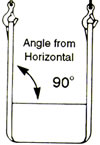 |
|
|
|
|
|
|
|
|
|
|
|
|
|
|
|
|
|
|
|
|
3.
Lifting Weight [LW] x the Tension
Factor [TF] = Minimum Sling Rating
for the type of hitch that will be used. |
|
|
|
Vertical
Basket
Hitch
|
|
|
|
*Measured
from a common horizontal plane to
the hoisting hook. |
|
|
|
|
|
|
|
|
|
|
|
|
|
|
|
*Measured
from a common horizontal
plane to the hoisting hook. |
|
|
|
|
|
|
|
|
|
|
|
|
|
|
|
|
|
|
|
|
|
|
|
|
|
|
|
|
|
|
|
|
|
Reduced
Capacity
|
|
|
|
|
|
|
|
|
|
|
|
Effect
of Angle Chart
|
|
Increasing
Tension
|
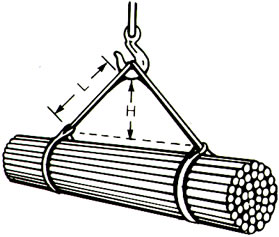 |
|
|
|
Reduction
Factor |
Angle
From
Horizontal |
Tension
Factor
(TF)
|
|
1.000 |
90º |
1.000 |
|
0.996 |
85º |
1.004 |
|
0.985 |
80º |
1.015 |
|
0.966 |
75º |
1.035 |
|
0.940 |
70º |
1.064 |
|
0.906 |
65º |
1.104 |
|
0.866 |
60º |
1.155 |
|
0.819 |
55º |
1.221 |
|
0.766 |
50º |
1.305 |
|
0.707 |
45º |
1.414 |
|
0.643 |
40º |
1.555 |
|
0.574 |
35º |
1.742 |
|
0.500 |
30º |
2.000 |
|
|
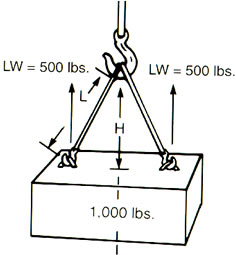 |
|
Example:
Vertical Choker rating of each sling = 6,000 lbs.
Measured Length (L) = 6 ft.
Measured Height (H) = 4 ft.
Reduction Factor (RF) = 4 (H) ÷ 6 (L) = .667
Reduced sling rating in this configuration = .667
(RF) x 6,000 lbs. = 4,000 lbs. of lifting capacity
per sling
|
|
|
|
|
Example:
Load Weight = 1,000 lbs.
Rigging - 2 slings in vertical hitch
Lifting Weight (LW) per sling = 500 lbs.
Measured Length (L) = 10 ft.
Measured Height (H) = 5 ft.
Tension Factor (TF) = 10 (L) ÷ 5 (H) = 2.0
Minimum Vertical Rated Capacity required
for this lift = 500 (LW) x 2.0 (TF) = 1,000
lbs. per sling
|
|
Sling
capacity decreases as the angle
from hjorizontal decrease. Sling angles
of less than 30° are not recommended. |
|
|
|
|
|
|
|
|
|
|
|
|
|
|
|
|
|
|
|
|
|
|
|
Polyester Roundslings,
Single Part Endless, Lifting Slings, Lift-All, Polyester Sling,
Eye and Eye, Braided Roundslings,
Tuflex, and Large Capacity Slings from your source for material
handling equipment.
|
Back to Product Page
|


